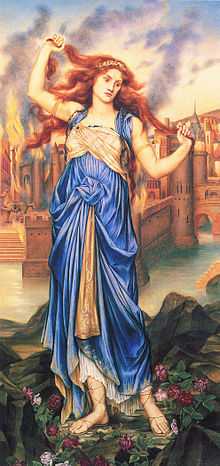Evelyn De Morgan

Evelyn De Morgan (30 August 1855 – 2 May 1919) was an English painter whose works were influenced by the style of the Pre-Raphaelite movement.[1] She was a follower of Pre-Raphaelist Burne-Jones.[2] Her paintings exhibit spirituality; use of mythological, biblical, and literary themes; the role of women; light and darkness as metaphors; life and death; and allegories of war.[3]
Biography

She was born Mary Evelyn Pickering.[1] to upper middle class parents Percival Pickering QC, the Recorder of Pontefract, and Anna Maria Wilhelmina Spencer Stanhope, the sister of the artist John Roddam Spencer Stanhope and a descendant of Coke of Norfolk who was an Earl of Leicester..[4]
Evelyn was educated at home and started drawing lessons when she was 15. On the morning of her seventeenth birthday, Evelyn recorded in her diary, "Art is eternal, but life is short…" "I will make up for it now, I have not a moment to lose." She went on to persuade her parents to let her go to art school. At first they discouraged it, but in 1873 she was enrolled at the Slade School of Art. She was granted a scholarship at Slade which entitled her to three years of financial assistance. However, since the scholarship required that she draw nudes using charcoal and she did not care for this technique, she eventually declined it.[5]
She was also a pupil of her uncle John Roddam Spencer Stanhope, who was a great influence on her works. Beginning in 1875, Evelyn often visited him in Florence where he lived. This also enabled her to study the great artists of the Renaissance; she was particularly fond of the works of Botticelli.[6] This influenced her to move away from the classical subjects favored by the Slade school and to make her own style. She first exhibited in 1877 at the Grosvenor Gallery in London and continued to show her paintings thereafter.[7]
In 1887, she married the ceramicist William De Morgan. They spent their lives together in London.[4] De Morgan, a pacifist, expressed her horror at the First World War and South African War in over fifteen war paintings including The Red Cross[1] and S.O.S.[8]Relative to artistic pursuits, money was unimportant to the De Morgans; any profits from sales of Evelyn's paintings went toward financing William’s pottery business and she actively contributed ideas to his ceramics designs.[1] Two years after his death in 1917, she died on 2 May 1919 in London and was buried in Brookwood Cemetery, near Woking, Surrey.[4]
Works
.jpg)
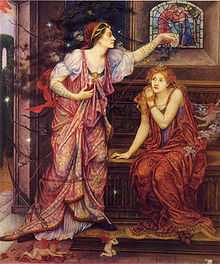
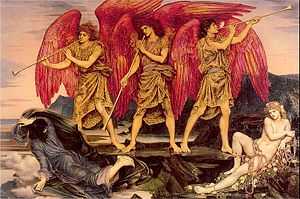
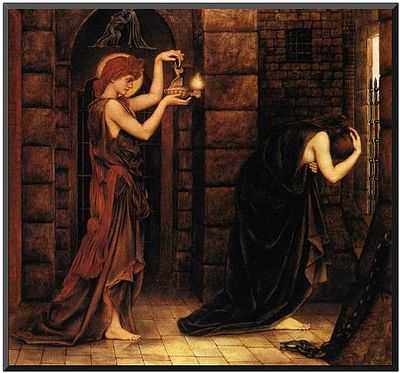

- Tobias and the Angel (1875)
- Cadmus and Harmonia (1877), De Morgan Centre, London.
- Ariadne at Naxos (1877), De Morgan Centre, London.
- Aurora Triumphans (1877–1878), Russell-Cotes Museum, Bournemouth.
- Night and Sleep (1878)
- Goddess of Blossoms & Flowers (1880)
- The Grey Sisters (1880–81), De Morgan Centre, London.
- Phosphorus and Hesperus (1882), De Morgan Centre, London.
- By the Waters of Babylon (1882–83), De Morgan Centre, London.
- Sleep and Death, the Children of the Night (1883), De Morgan Centre, London.
- Salutation or The Visitation (1883),
- Love's Passing (1883–1884), De Morgan Centre, London.
- Dryad (1884–85), De Morgan Centre, London.
- Luna (1885), De Morgan Centre, London.
- The Sea Maidens (1885–86), De Morgan Centre, London.
- Hope in a Prison of Despair (1887)
- The Soul's Prison House (1888), De Morgan Centre, London.
- Love, the Misleader (1889), private collection.
- Medea (1889), Williamson Art Gallery, Birkenhead.
- Angel of Death (1890), private collection.
- The Garden of Opportunity (1892), De Morgan Centre, London.
- Life and Thought Emerging from the Tomb (1893), Walker Art Gallery, Liverpool.
- Flora (1894), De Morgan Centre, London.
- Eos (1895), Columbia Museum of Art, Columbia, South Carolina.
- The Undiscovered Country, Columbia Museum of Art, Columbia, South Carolina
- Lux in Tenebris (1895), De Morgan Centre, London.
- Boreas and Oreithyia (1896), De Morgan Centre, London.
- Earthbound (1897), De Morgan Centre, London.
- Angel of Death (1897), private collection.
- Helen of Troy (1898)
- Cassandra (1898), De Morgan Centre, London.
- The Valley of Shadows (1899), De Morgan Centre, London.
- The Storm Spirits (1900), De Morgan Centre, London.
- The Poor Man who Saved the City (1901), De Morgan Centre, London.
- The Love Potion (1903)
- The Cadence of Autumn (1905), De Morgan Centre, London.
- Queen Eleanor & Fair Rosamund (1905), De Morgan Centre, London.
- Death of a Butterfly (c.1905–10), De Morgan Centre, London.
- Demeter Mourning for Persephone (1906), De Morgan Centre, London.
- Port after Stormy Seas (1905), De Morgan Centre, London.
- The Hour-Glass (1905), De Morgan Centre, London.
- The Prisoner (1907), De Morgan Centre, London.
- Our Lady of Peace (1907), De Morgan Centre, London.
- The Worship of Mammon (1909), De Morgan Centre, London.
- Death of the Dragon (1914), De Morgan Centre, London.
- The Vision (1914), private collection.
- The Red Cross (1918), De Morgan Centre, London.
- The Gilded Cage (1919), De Morgan Centre, London.
- Deianera (unknown)
- The Kingdom of Heaven Suffereth Violence
Paintings
-

The Crown of Glory
-

Flora
-

Cadmus and Harmonia
-
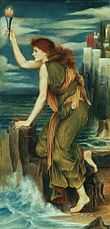
Hero Holding the Beacon for Leander
External links
| Wikimedia Commons has media related to Evelyn de Morgan. |
- "Evelyn De Morgan" at The Bridgeman Art Library
- De Morgan Foundation
- Grave of Evelyn and William De Morgan
- Portraits of (Mary) Evelyn De Morgan (née Pickering) at the National Portrait Gallery, London
References
- ↑ 1.0 1.1 1.2 1.3 Rachel S. Gear, ‘Morgan, (Mary) Evelyn De (1855–1919)’, Oxford Dictionary of National Biography, Oxford University Press, 2004; online edn, May 2006 accessed 7 March 2015
- ↑ Joellen Secondo. "De Morgan." Grove Art Online. Oxford Art Online. Oxford University Press, accessed March 7, 2015, http://www.oxfordartonline.com/subscriber/article/grove/art/T022113pg2.
- ↑ Smith, E. L., & De Morgan, M. (2002). Evelyn Pickering De Morgan and the allegorical body. Madison [N.J.] : London ; Cranbury, NJ: Fairleigh Dickinson University Press.
- ↑ 4.0 4.1 4.2 Smith, Elise (2002). Evelyn Pickering De Morgan and the Allegorical Body. Madison, NJ: Fairleigh Dickinson University Press. ISBN 978-0-8386-3883-5.
- ↑ Joellen Secondo. "De Morgan." Grove Art Online. Oxford Art Online. Oxford University Press, accessed March 7, 2015, http://www.oxfordartonline.com/subscriber/article/grove/art/T022113pg2.
- ↑ J. Paul Getty Trust, Union List of Artist Names (ULAN); accessed 7 March 2015
- ↑ Joellen Secondo. "De Morgan." Grove Art Online. Oxford Art Online. Oxford University Press, accessed March 7, 2015, http://www.oxfordartonline.com/subscriber/article/grove/art/T022113pg2.
- ↑ "The De Morgan Foundation". http://www.demorgan.org.uk/S.O.S''.
|

